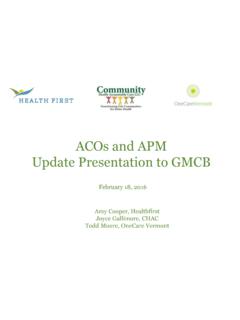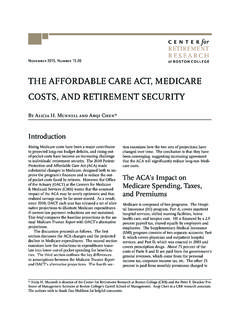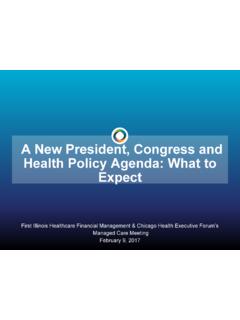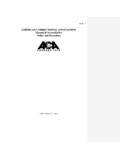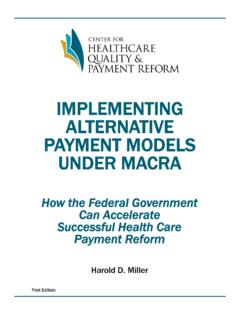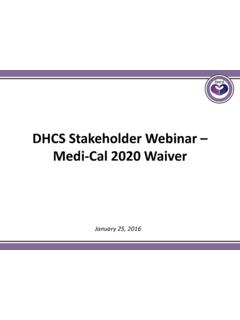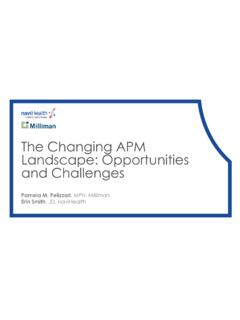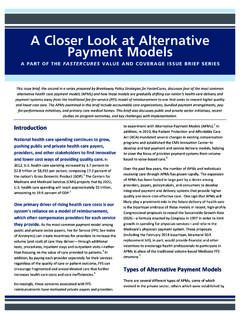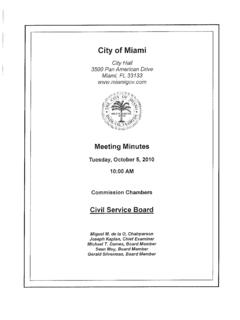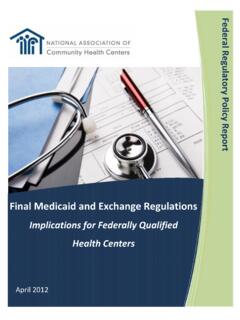Transcription of STATE OF VERMONT GREEN MOUNTAIN CARE …
1 STATE OF VERMONT GREEN MOUNTAIN care board In re: VERMONT All-Payer Accountable care ) Organization Model Agreement ) ) ) Introduction The rising cost of health care imposes unsustainable financial burdens on Vermonters and their families, impedes equitable access to preventive care , and threatens to cripple our STATE s economy. Left unchecked and uncontrolled, it will prevent VERMONT from reaching its goal to ensure that all of its citizens have access to affordable, high-quality health care . The problem is not unique to VERMONT Congress enacted the Patient Protection and Affordable care Act of 2010 (ACA), for example, to address our national health care crisis. The VERMONT All-Payer Accountable care Organization Model ( All-Payer Model or Model ) is an agreement ( the Agreement ) between the STATE and the Centers for Medicare and Medicaid Services (CMS) that allows VERMONT to explore new ways of financing health care with Medicare s participation, through an Accountable care Organization (ACO) delivery model.
2 Principle 7 from the Health care Payment Learning Action Network (LAN) states : Centers of excellence, patient centered medical homes, and accountable care organizations are delivery models, not payment models. In many instances, these delivery models have an infrastructure to support care coordination and have succeeded in advancing quality. They enable Alternative Payment Models (APMs) and need the support of APMs, but none of them are synonymous with a specific The All-Payer Model is an Alternative Payment Model, facilitated by an ACO, that enables the three main payers of health care in VERMONT Medicaid, Medicare, and commercial insurance to pay for health care differently than through fee-for-service reimbursement under a common structure, initially including hospital and physician services in Medicare and their commercial and Medicaid equivalents; previously in VERMONT , the ACO delivery model has been paired only with a payment model that has a fee-for-service foundation.
3 The Agreement envisions a statewide All-Payer Model that aligns and amplifies incentives across all payers to promote participation, by Model s end, by the majority of providers in the STATE . At its public board meeting on October 26, 2016, this board voted to enter into the Agreement with CMS, which we believe will transition our provider reimbursement model from one that incentivizes quantity to one that is value-based and rewards positive health outcomes. Below, we discuss the All-Payer Model s background, the Agreement s terms, and the reasoning for our support. Development of the All-Payer Model The fee-for-service reimbursement model, which compensates health care providers and facilities for each health care service and care component delivered, is the most prevalent form of provider compensation in our country today, yet is widely recognized as a significant driver of health care spending growth.
4 By creating incentives for the health care system to perform a high volume of health care services, fee-for-service reimbursement does not compensate providers for important time spent coordinating care with other providers or community services, sending e-mails, making phone calls, or talking with patients and their families about 1 Alternative Payment Model Framework and Progress Tracking (APM FPT) Work Group, Health care Payment Learning & Action Network, Alternative Payment Model (APM) Framework Final White Paper, 11 (Jan. 12, 2016), available at 2 factors that may be negatively impacting a patient s health status. The fee-for-service model rewards the quantity of work done, not its quality; it does not incentivize providers based on improved health care Act 48 In 2011, the VERMONT Legislature passed Act 48 in an effort to ensure that all Vermonters could access high-quality, affordable health care .
5 Citing a paramount need for reformation of the payment system for health services to encourage quality and efficiency, 3 Act 48 created the GREEN MOUNTAIN care board and specifically authorized the board to develop and implement payment and delivery system reforms to control the rate of growth in health care costs and maintain or improve health care quality in VERMONT . Defining payment reform as modifying the method of payment from a fee-for-service basis to one or more alternative methods for compensating health care measuring quality and efficiency, 4 Act 48 ascribes a series of duties and responsibilities to the board , guided by fourteen principles for health care reform. Among its other duties, Act 48 expressly empowers the board to: [o]versee the development and implementation, and evaluate the effectiveness, of health care payment and delivery system reform designed to control the rate of growth in health care costs and maintain health care quality in Act 48 specifically calls for the board to develop, implement and evaluate payment reform pilot projects, and makes clear that health insurers, Medicaid, Medicare, and other payers should reimburse health care professionals with consistent payment methodologies that provide incentives to coordinate care and control cost Federal Reform Activity Federal legislation has helped pave the way for work at the STATE level.
6 The ACA created the Center for Medicare and Medicaid Innovation (CMMI) to test innovative payment and service delivery models to reduce federal health care program expenditures and to improve the quality of care received by Medicare, Medicaid, and Children s Health Insurance (CHIP) In 2013, CMMI awarded STATE Innovation Model (SIM) grants to six states , including VERMONT , for alternative payment model testing, emphasizing multi-payer payment reforms that are consistent with the goals of Act With support from the SIM grant, the board exercised its authority under Act 48 and created an aligned, multi-payer Shared Savings Program (SSP) payment reform pilot for ACOs, modeled after Medicare s Track 1, one-sided risk SSP. In 2014 and 2015, more than 150,000 Vermonters were attributed to Commercial, Medicaid, or Medicare SSP-participating providers.
7 During the first two years of the Medicaid SSP, the two participating ACOs saved the Medicaid program more 2 See Mark McClellan, Reforming Payments to Healthcare Providers: The Key to Slowing Healthcare Cost Growth While Improving Quality?, 25 J. of Economic Perspectives No. 2, Spring 2011, at 69 92; Ezekiel J. Emanuel & Victor R. Fuchs, The Perfect Storm of Overutilization, 299 J. Am. Med. Assoc. 2715, 2789 91 (2008); Lorens A. Helmchen & Anthony T. Lo Sasso, How Sensitive is Physician Performance to Alternative Compensation Schedules? Evidence from a Large Network of Primary care Clinics, 19 Health Economics 1259, 1300 17 (2010); Steven A. Schroeder & William Frist, Phasing Out Fee-for-service Payment, 368 N.
8 Engl. J. Med. 1953, 2029 32 (2013). 3 3 2222a(c)(9). 4 18 9373(12). 5 18 9375(b)(1). 6 18 9377. 7 42 1315a (CMMI is created to test innovative payment and service delivery models to reduce program expenditures .. while preserving or enhancing the quality of care . ). 8 In VERMONT , the STATE Innovation Model work is now called the VERMONT Health care Innovation Project (VHCIP). 3 than $ million due to actual expenditures that were below the targets and both ACOs participating in the Medicaid SSP achieved improvements in their overall quality scores from 2014 to 2015. When aggregating financial results across the duration of the Commercial SSP, savings were not realized. However, two of the three ACOs participating in the Commercial SSP achieved improvements in their overall quality scores from 2014 to 2015, and the third ACO maintained a very high overall quality score in both years.
9 In the Medicare SSP, savings were not realized when aggregating financial results across the duration of the program; all three VERMONT ACOs that have participated in the program have achieved strong quality scores that exceed the national average. VERMONT s all-payer SSP is still built on a fee-for-service foundation, however, providing for savings only if the ACOs spend less than a targeted amount. CMS has since designed and begun implementation of new population-based payment programs that are not attached to fee-for-service reimbursement. In 2015, CMS announced the Next Generation ACO Program. Next Generation builds on the SSP model, but allows provider groups to assume higher levels of financial risk and reward than are currently available either in an SSP or Pioneer ACO The Next Generation ACO model provides for capitation, in which the ACO receives monthly per-beneficiary-per-month (PBPM) capitation payments and is responsible for paying claims for ACO providers, constituting a considerable move away from fee-for-service.
10 Moreover, working toward its goal to link 50% of Medicare payments to alternative payment models by 2018,10 Congress s bipartisan passage of the Medicare Access and CHIP Reauthorization Act of 2015 (MACRA)11 significantly shifts the Medicare payment system away from one that is volume-driven toward one that is value-based. Under MACRA, all Medicare providers (including physicians, physician assistants, nurse practitioners, clinical nurse specialists and certified registered nurse anesthetists) who deliver a designated threshold of care must participate in one of two payment tracks for Medicare Part B either an Advanced Alternative Payment Model (APM) or the Merit-based Incentive Payment System (MIPS) under the law s Quality Payment Program (QPP). Providers who choose to participate in Advanced APMs are exempt from MIPS reporting requirements and can earn 5% incentive payments; providers not in an Advanced APM are subject to MIPS and will receive performance-based payment adjustments that increase incrementally beginning with +/- 4% in 2019, and reach +/- 9% in 2022.
